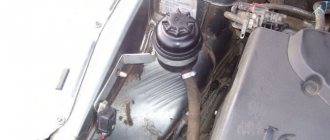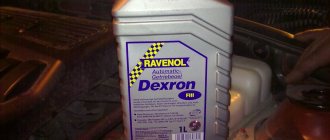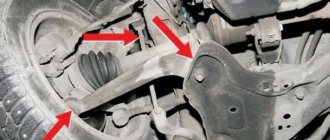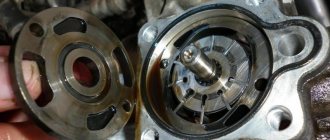01/25/2022 5,863 Lubrication system
Author: Victor
The hydraulic booster is the main component in the steering system of Ford vehicles. Thanks to the amplifier, simplified steering wheel control is provided. This system requires periodic diagnostics and maintenance, including oil changes. Find out from this material about Ford Focus 2 power steering fluid, which you can replace on your own.
[Hide]
When is an oil change required?
First, let's look at when it is necessary to change the power steering fluid and what is the frequency of replacement. According to technical regulations, the manufacturer fills this consumable into the system for the entire service life of the vehicle. But as a result of prolonged operation of the hydraulic system of a Ford Focus restyling, pre-restyling 2008, 2013 (or other year of manufacture), the quality of the lubricant may deteriorate during the active operation stage.
It is necessary to periodically check the condition of the oil, as well as its volume in the expansion tank. It is located in the engine compartment, on the right, near the engine mount.
Expansion tank for amplifier fluid
To effectively determine the quality of a consumable, you will need a syringe, with which you take a little oil from the tank and then drop it on a piece of paper or a napkin. The hydraulic booster system can use two types of oil - red and green. If you drop grease onto the paper and see that the color has not changed, then the consumable does not need to be changed. If the liquid has turned brown or black, and a burning smell is coming from the reservoir, then the substance must be changed. The need for replacement is indicated by deterioration in the quality of vehicle control and the appearance of extraneous sounds when turning the steering wheel.
Let’s summarize the “symptoms”, the presence of which indicates the need to change the fluid:
- The appearance of extraneous sounds, creaking when turning the steering wheel. This can happen on both a cold and warm engine.
- Difficulty turning the steering wheel. The driver needs to put in more effort to turn.
- Deterioration in the quality of consumables. Changing the original color of the liquid.
- Presence of a burning smell in the expansion tank.
Experienced car enthusiasts recommend changing the oil every 2-3 years, or at least every 100 thousand kilometers.
How much oil is in power steering Ford Focus
First generation I, 1998-2004
The Focus has become a successful replacement for the once popular Escort, judging by its strong sales. The family included a sedan, hatchback and station wagon, and a wide range of engines consisted of 1.4, 1.6, 1.8 and 2.0 liter petrol engines (75-130 hp). Diesel 1.8 (90-116 hp) was also available, as well as a forced Duratec 2.0 (170-215 hp) for charged modifications of the Focus S170 and Focus RS. In America, the car was offered with 2.0 and 2.3 liter engines. As for appearance, Focus in its class became one of the founders of the new design direction of Ford New Edge, also familiar from the Ford Ka 1996 and Cougar 1998 models.
Power steering oil: volume – 1 liter
Second generation II, 2004-2010
In technical terms, the second generation Focus was almost no different from the popular Volvo (S40, V50 and C70) and Mazda (3, 5) models, which were also built on the Ford C1 platform. The suspension design is largely borrowed from the first generation Focus. The same applies to body types - sedan, hatchback and station wagon, to which a convertible was also added. In Russia, the car was offered with 1.4, 1.6, 1.8 and 2.0 liter petrol engines (80-145 hp), as well as a 1.8 diesel engine (115 hp). At the top of the family are the “charged” modifications ST and RS with 2.5-liter engines producing up to 305 hp. With. Moreover, in 2010, a limited edition RS500 with a 345-horsepower engine was released.
Which oil is better to choose?
Original product for Focus power steering
Before changing the lubricant in the hydraulic booster, you need to determine what brand of fluid should be filled. The original power steering oil belongs to the category of synthetic lubricants. The manufacturer recommends casting original products, since they make it possible to ensure reliable and stable operation of the system. This product performs its functions at air and motor temperatures from -40 to +120 degrees.
Options for filling into Ford power steering:
- Ford WSA/M2C938/A. The product is red, its article number is 1776431. The cost of one liter of lubricant is on average 1,400 rubles.
- Liquid for Ford M2C204/A2 USA. This is a green original liquid with article number 1781003, which is a cheaper option, its cost is approximately 600 rubles per liter of lubricant.
As analogues, the use of red Motorcraft Merkom LV oil is allowed. Another inexpensive option is SWAG Febi (up to 600 rubles per liter).
The ABC Ford channel has provided a video that will allow you to choose a power steering fluid.
Checking the level and topping up
Learn more about how to check the amount of lubricant in the power steering system. Diagnostics of the consumable level is carried out on a flat surface. The oil reservoir has two marks: MIN and MAX. If the power unit of the machine is turned off, then the volume of working fluid will most likely be maximum. If the lubricant level is closer to the minimum, then lubricant must be added to the system. How much to pour depends on the volume that is missing.
How to detect a leak?
To independently identify the location of the leak, do the following:
- Stop the engine and wait until it cools down.
- Wipe all components of the steering system with a rag, especially the pipes and connections.
- Check the amount of lubricant in the expansion tank. If necessary, add liquid.
- Start the power unit and turn the steering wheel left and right as far as possible. As a result of rotation, the lubricant will begin to actively circulate throughout the system. If there is damage, you will be able to see the leak. Depending on the problem, decisions are made to eliminate it.
Causes of leakage and their elimination
Most often, the steering rack leaks in Focus cars. If there is a malfunction in the operation of this unit, this leads to leakage of consumables.
Signs of a problem:
- While driving, a knocking sound appears in the area of the rack, which can be clearly heard through the steering wheel.
- There was a gap when turning the steering wheel.
- Extraneous sounds have appeared in the operation of the hydraulic booster pumping device.
- The driver has to exert more effort to rotate the steering wheel.
One of these “symptoms” indicates a lack of fluid and the need to diagnose the system for leaks. Malfunctions associated with the operation of the rack can be eliminated with your own hands. To do this, the rack must be removed from the car and disassembled. All worn components found during diagnostics must be replaced. Then the rack is assembled and then installed in the car.
The reason may be that the power steering pump is not working. The pumping device operates under conditions of high loads, so over time, malfunctions appear in the operation of the unit. Also, the reason may lie in a violation of the tightness of the device or damage to the pipes and lines through which the lubricant circulates. To solve the problem, you need to visually diagnose the hoses and replace them. If there are cracks or other defects, the lines must be replaced. It is advisable to overhaul the pumping device and install new seals in it.
Sometimes it happens that the steering wheel turns freely, but as the engine warms up, you have to put more effort into turning it. This indicates a malfunction of the pumping device and leakage of consumables. The unit must be dismantled and disassembled. The device is visually inspected for damage. All failed parts are replaced with new ones, and before assembly, all elements are wiped with alcohol or solvent. If the seals of the lines are broken, all pipes of the system must be carefully inspected for reliability and strength. If you doubt the quality of the tightness of the connecting components, they must be updated and securely fixed.
Preparing for replacement
To complete the changing procedure, you will need the oil itself, green or red. Any lubricant is not suitable, buy either the original or a high-quality analogue, which we wrote about above. A complete replacement will require at least two liters of consumables. In general, the process of changing in Ford Focus cars does not cause any particular difficulties, but with an assistant it will be easier to complete this task.
You will need a pipe equipped with a special fitting at the end. The length of the hose will be at least one meter, and its diameter should be the same as the return line. To determine the return diameter, look at the fluid reservoir under the hood. There are two pipes suitable for the tank: one connects to the pump, the other goes directly to the tank. You will need another pipe, but its length will be shorter, and there will be a plug at the end. Also prepare a container in which you will collect the used oil.
User Alex M published a video showing the process of replacing fluid in the Focus power steering.
Reviews
David, Kyiv region. I drive a second generation Focus. I have the most popular 1.6-liter version at that time with a machine gun, the rate of fire of which I’d rather not say anything about. For a leisurely drive it’s fine, but with sudden acceleration the automatic turns into a lazy vegetable. Mechanically, everything would be much better, because the engine itself is excellent, despite only 100 horses. Consumes 11 liters, but with frequent gearbox switching it can get 12 liters.
Valery, Irkutsk. I have a third generation Focus, I bought it on the secondary market in 2022. This I chose a pre-restyling model, which looks more original in comparison with the updated Focus, which does not at all suit the image of Aston Martin. This is not Chinese, after all. The 1.6 engine runs quietly, largely due to good sound insulation. In terms of practicality, not everything is clear - the rear tall passengers are quite cramped, but the trunk volume was pleasing.
Stages of work
To replace the power steering lubricant, do the following:
- Drain the used liquid. Stop the engine and open the fluid expansion tank. Unscrew the bolts that secure it and disconnect the pipes connected to it. This will lead to consumables leaking out, so place a container in advance (maybe a cut-off bottle) with a volume of at least two liters.
- We connect the clamp. Using long-end pliers, hook the clamp from the return line and move it to the side. The clamp is connected to the expansion tank with consumables.
- We provide access. Disconnect the return line pipe, and then install the fitting from a previously prepared hose. Instead of a pipe, a tube with a plug is used.
- We fill in new material. Open the reservoir cap and fill it with new lubricant. Consider some points here. While you are adding lubricant, your assistant should start the power unit. When filling, monitor the color of the consumable material, which is pumped out of the reservoir under the influence of pressure in the pump. When fresh lubricant comes out of the tank, differing from the used one in color and smell, the engine must be stopped. When filling, do not allow air to enter the system, this will lead to the formation of plugs that will subsequently have to be removed.
- The final stage. Top up to the maximum level, then start the engine and let it run. Make a test drive and check the lubricant level again. Add fluid to the system if necessary. All components are assembled in reverse order.
Photos of replacing consumables are shown below.
1. Drain the lubricant from the reservoir and plug the return line
2. Fill the hydraulic steering system with new oil.
When replacing lubricant, do not allow it to come into contact with the timing belt, otherwise it will cause rapid wear.
Replacing power steering fluid Ford Focus 3
0:7 Problem with Ford Focus 3
0:47
I once opened the power steering reservoir of a Ford Focus 3 and smelled the fluid - it smelled burnt and very strong. Later I went to check the level - the level is normal, but the liquid leaves some black marks on the walls of the tank, and the power steering began to make noise in extreme positions, so it was decided to change it. Task: replace power steering fluid in Ford Focus 3
0:626
Progress of work on replacing power steering fluid on Ford Focus 3
0:709
1:1216
Assembling the stand
1:1249
A crane assistant is important because a good owner can find in his garage the most necessary things to carry out this procedure.
1:1483
Progress of work on replacing power steering fluid on a Ford Focus 3: 1. Buy power steering fluid. I firmly believe that the power steering has not changed at all since the 2nd Focus; moreover, I personally know several cars that drive quite comfortably with power steering pumps from the second Focus, so I bought this fluid because The standard one has a higher viscosity and is more difficult for the pump to pump:
1:2108
2:506
For normal flushing, and we flushed the system 3 times, it took me 1.5 liters. Even if we didn’t wash it so thoroughly, 1 bottle would still not be enough for us, so only 2.
2:813
2. Remove the headlight and find the reservoir; 2 hoses go to it.
2:920
3:1427
the one that goes down is the one that feeds the pump, the one on the side is
3:1532
3. We pump out the liquid from the tank, I highly recommend going to any medical equipment store (not in pharmacies - I went around 6 pieces) and buy a Janet syringe and a feeding tube for it - 120 rubles.
3:1854
4. Remove the tank. At first we thought about just changing the fluid, but after looking there we realized that ideally it would need to be changed or washed. DO NOT DRAIN THE LIQUID FROM THE SUPPLY PIPE! (In general, everything must be done to prevent the pump from swallowing air.) For cleaning, it was decided to use a special product - a universal cleaner and white spirit.
3:2446
5. Next, our task is to return the tank to its place and assemble a small stand: 1. Using a hose of suitable diameter, a bolt and 2 clamps, plug the return hole on the tank. 2. We connect an extension cord to the return hose (it would be possible without it, but there is very little space there) and lower it into the drain container.
3:538
4:1045
5:1552
3. Turn on the IGNITION! DO NOT START Ford Focus 3 ENGINE! We open the windows to hear our partner.
5:1729
4. This is the most important stage, because The power steering pump at the focal points is not the strongest place and the air can kill it, moreover, if you still take a breath of air, it will not be very easy to expel it from there. Now carefully start the engine for a couple of seconds. The level from the tank drains quickly. The pump will empty the tank 100% in 3-4 seconds, so we listen to our partner and manage to turn off the engine. Turn it off, top it up to full and start again. We repeat the procedure until clean liquid begins to flow into the drain tank of our partner. 5. This is what came out for me. Mileage 41,000, it is impossible to determine the color. There is sediment in the liquid
5:2838
6:506
7:1013
6. Next, we return everything back, top it up to the maximum, start the car and turn the steering wheel from side to side until it stops several times, and the power steering fluid level will drop slightly. Top up to the maximum and monitor for a couple of days for leaks in the system.
7:1477 8:1984
I actually drained the reservoir 2 more times with a syringe after turning the steering wheel, because with this method, residues remain in the hydraulic cylinders in the rack.
8:2230
Conclusions after a week of operation: 1. The howling in extreme positions has gone away 2. The steering wheel has become easier to turn, noticeably easier. Overall I'm 200% satisfied
8:250
Result: work on replacing power steering fluid on a Ford Focus 3 has been completed.
8:368
https://www.drive2.ru/l/7265079/
8:406 Rating 4.83 [6 Votes] 17735
Consequences of untimely replacement
If the fluid is replaced at the wrong time, this usually causes accelerated wear of the components of the hydraulic booster system. Because of this, power steering parts will begin to wear out faster and fail. First of all, oil seals and gaskets are subject to wear, the appearance of defects on which leads to lubricant leakage.
What can happen as a result of untimely replacement:
- failure of the steering rack;
- lubricant leakage from the system;
- the appearance of creaking and other noises when turning the steering wheel;
- failure of the steering gear;
- the appearance of difficulties when turning the steering wheel.
What mistakes should you avoid when operating power steering?
To avoid problems in the operation of the hydraulic booster, you must follow certain rules for using the system:
- Correct steering wheel position. The steering wheel should not be held in the extreme left or right position for a long time, but turn off the power unit by turning the wheels. This negatively affects the operation of the pumping device, since the load on it increases. To reduce the load level, the steering wheel must be moved a few centimeters from its extreme position.
- Precautionary measures. Limit vehicle operation if the hydraulic booster does not work.
- Oil level control. Always check the lubricant level in the expansion tank. If the lubricant volume is too low, the cause must be determined and eliminated, and before that, do not use the machine.
- Be careful when parking. Do not overload the hydraulic booster when parking the vehicle. If you feel that the side surfaces of the wheels are resting against the curb, do not continue to turn the steering wheel.
- Rules for winter. Before starting a trip in winter, you need to warm up the hydraulic booster by smoothly turning the steering wheel in different directions. The amplitude of rotation should not be large.
Why did it happen so?
Perhaps the automatic requests do not belong to you, but to another user accessing the network from the same IP address as you. You need to enter the characters into the form once, after which we will remember you and be able to distinguish you from other users exiting from this IP. In this case, the page with the captcha will not bother you for quite a long time.
You may have add-ons installed in your browser that can make automatic search requests. In this case, we recommend that you disable them.
It is also possible that your computer is infected with a virus program that is using it to collect information. Maybe you should check your system for viruses.
If you have any problems or would like our support team, please use the feedback form.
The Ford Focus 3 is equipped with power steering, a system designed to facilitate the process of driving and maneuvering. Also, thanks to the device, the specified trajectory is more stable and unambiguous. For proper operation of the power steering, periodic maintenance, oil changes, and level monitoring are required.
We recommend inspection every six months and replacement after 2 to 5 years, taking into account the conditions in which the machine is operated. We should not forget about problems that lead to the need for premature replacement of workers.
Video “How to pump the power steering yourself?”
If after replacing the fluid the hydraulic booster does not work, check out the video made by user Sasha Petrov, which will help you figure out how to bleed the system.
Do you have any questions? Specialists and readers of the AUTODVIG website will help you ask a question
Was this article helpful?
Thank you for your opinion!
The article was useful. Please share the information with your friends.
Yes (100.00%)
No
X
Please write what is wrong and leave recommendations on the article
Cancel reply
Rate this article: ( 7 votes, average: 5.00 out of 5)
Discuss the article:











